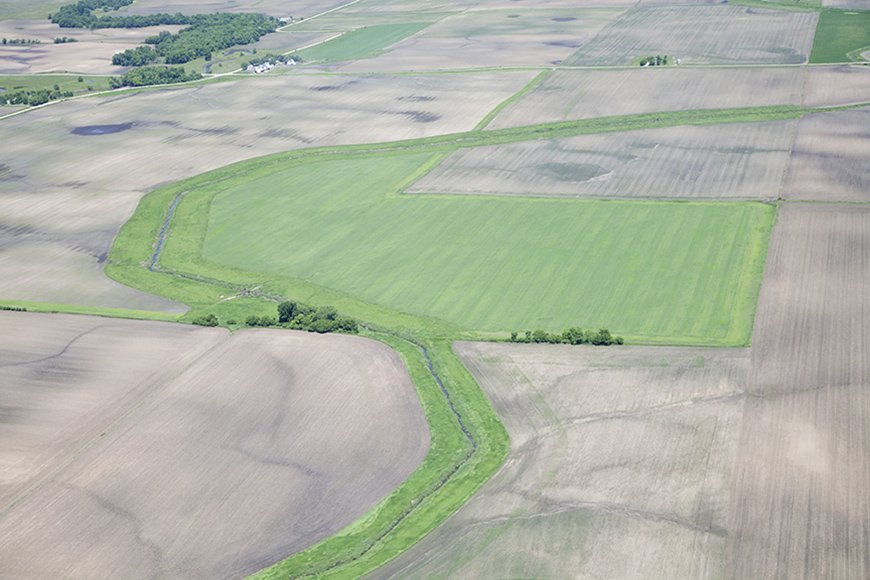Slow the Flow with Buffer Strips

Here in Minnesota we’ve been hearing a lot of chatter about implementing buffer strips in agricultural land as a way to help protect surface waters from pesticide, nutrient and soil runoff. If you’re wondering about the benefits of buffer strips or are ready to implement them on your farm, here’s some background information to get started.
Common Sense Conservation
Buffer strips are small areas of land or strips of land that are permanently vegetated within or around an agricultural field to mitigate the movement of sediments, nutrients and pesticides from farm operations to surface waters such as rivers, streams, and lakes.
Nutrients that easily bind to soil particles, like phosphorus, move from fields to surface waters as runoff. Streams, rivers, and lakes become enriched with these nutrients and algae grows more quickly, depleting oxygen for aquatic life. Buffer strips help capture nutrients, preventing them from polluting water sources.
The Natural Resources Conservation Service estimates that properly installed and maintained buffers can remove 50 percent or more of nutrient and pesticides and 75 percent of sediment from agricultural runoff. An added benefit of buffer strips is reduced flood damage to crops.
Plan Buffers Before Planting Season
Buffers should be planted at the appropriate time for the species selected, and when there is adequate moisture for germination and stand establishment. Planning buffer strips before planting agricultural fields may save time and money on seeding and inputs, since this land won’t be in production. In addition, government programs have specific guidelines for completion, so it’s best to begin early in the season.
To get started, meet with your local crop advisor or government agency that supports conservation planning. There may be specific buffer design requirements you’ll need to consider to earn financial incentives from government programs. Buffer strips typically range in size from 20 to 120 feet wide, depending on field characteristics. Deep-rooted grasses and native plants intercept runoff effectively and can minimize erosion. In flat areas where wind is a problem, trees and shrubs can act as a windbreak to prevent the erosion of topsoil.
Keys for Buffer Maintenance
Once you’ve got your buffer strip established, it’s important to properly maintain it. Here are some tips to keep in mind:
Common Sense Conservation
Buffer strips are small areas of land or strips of land that are permanently vegetated within or around an agricultural field to mitigate the movement of sediments, nutrients and pesticides from farm operations to surface waters such as rivers, streams, and lakes.
Nutrients that easily bind to soil particles, like phosphorus, move from fields to surface waters as runoff. Streams, rivers, and lakes become enriched with these nutrients and algae grows more quickly, depleting oxygen for aquatic life. Buffer strips help capture nutrients, preventing them from polluting water sources.
The Natural Resources Conservation Service estimates that properly installed and maintained buffers can remove 50 percent or more of nutrient and pesticides and 75 percent of sediment from agricultural runoff. An added benefit of buffer strips is reduced flood damage to crops.
Plan Buffers Before Planting Season
Buffers should be planted at the appropriate time for the species selected, and when there is adequate moisture for germination and stand establishment. Planning buffer strips before planting agricultural fields may save time and money on seeding and inputs, since this land won’t be in production. In addition, government programs have specific guidelines for completion, so it’s best to begin early in the season.
To get started, meet with your local crop advisor or government agency that supports conservation planning. There may be specific buffer design requirements you’ll need to consider to earn financial incentives from government programs. Buffer strips typically range in size from 20 to 120 feet wide, depending on field characteristics. Deep-rooted grasses and native plants intercept runoff effectively and can minimize erosion. In flat areas where wind is a problem, trees and shrubs can act as a windbreak to prevent the erosion of topsoil.
Keys for Buffer Maintenance
Once you’ve got your buffer strip established, it’s important to properly maintain it. Here are some tips to keep in mind:
- Inspect grass buffer strips periodically and reseed any eroded areas.
- Prescribed burns and mowing can help with weed control until native vegetation is well established. Your local soil and water conservation district can provide recommendations.
- Periodic grading of the buffer strip may be needed, depending on the amount of sediment deposition.
- Adequate stand densities of the seeded species should be maintained, while controlling undesirable weed species.
- Limited livestock grazing may be appropriate, as long as it is controlled to avoid erosion.

